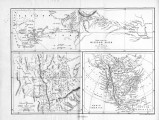| OCR Text |
Show CHAP. IX. CEMETERY.-THE WORD "MORMON." 361 plum-trees from Kew Gardens, French and Californian grapes, wild plum and buffalo berry, black currants, peaches, and apples -with which last we were hospitably loaded-in numbers. The kitchen garden contained rhubarb, peas, potatoes, Irish and sweet, asparagus, white and yellow carrots, cabbages, and huge beets: 'the sugar-cane had been tried there, but it was not, like the sweet holcus, a success. The last time I walked out of Great Salt Lake City was to see the cemetery, which lies on the bench to the northeast of the settlement. There is but one cemetery for saint and sinner, and it has been prudently removed about three miles from the abodes of the living. The tombs, like the funeral ceremonies, are simple, lacking the " monumental mockery" which renders the country church-yard in England a fitter study for farce than for elegy. On occasions of death, prayers are offered in the house, and the corpse is carried at once to its last home. The grave-yard is walled round, and contains a number of occupants, the tombs being denoted by a stone or board, with name and date, and sometimes a religious sentence, at the head and foot. CHAPTEE IX. Latter-Day Saints.-Of the Mormon Religion. No less an authority than Alexander von Humboldt has characterized positive religions in general as consisting of an historical novelette more or less interesting, a system of cosmogony more or less improbable, and a code of morals mostly pure.* Two thirds of this description apply to the faith of the Latter-Day Saints: they have, however, escaped palseological criticism by adopting Genesitic history, and by " swallowing Eve's apple" in the infancy of their spiritual life. Before proceeding to comment upon the New Dispensation- for such, though not claiming or owning to be, it is-I may compare the two leading interpretations of the word "Mormon," which, as has been well remarked,f truly convey the widely diverging opinions of the opposers and supporters of Mormonism. Mormon (jiopfiwv) signifies literally a lamia, a maniola, a female spectre; the mandrill, for its ugliness, was called Cynocephalus mormon. "Mormon," according to Mr. Joseph Smith's Mormonic, or rather Pantagruelic interpretation, is the best-sal., of mankind. " We * A somewhat free version of "toutes les religions positives offrent trois parties distinctes; un traite de moeurs partout le meme et tree pur, un reve ge"ologique, et un mythe ou petit roman historique: le dernier dMment obtient le plus d'importance." -LX. Letter, Dec. 3d, 1841. t The Mormons, or Latter-Day Saints, by Lieutenant J. W. Gunnison, of the United States Topographical Engineers. Philadelphia, 1852. |



















































































































































































































































































































































































































































































































































































































